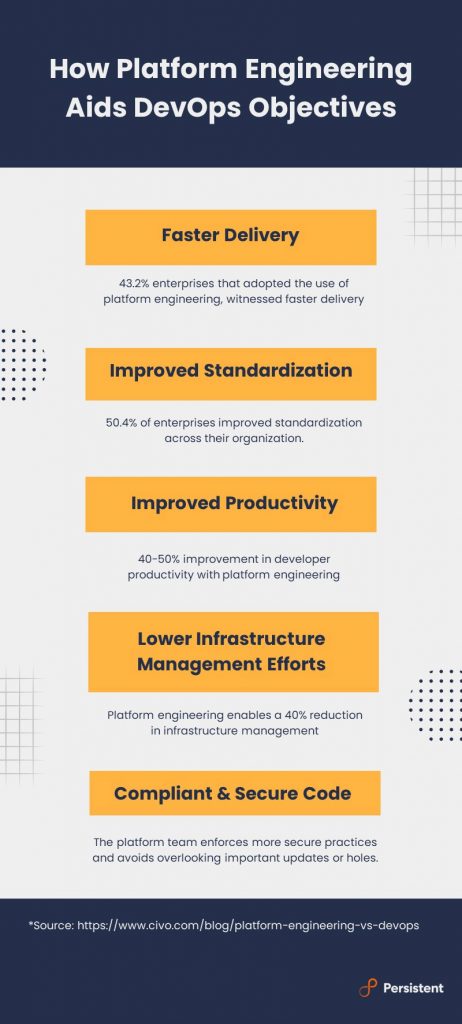Platform engineering, or the technology approach that abstracts the provisioning and management of under-the-hood infrastructure, is an emerging trend in developer circles, mainly because the frustrations around speed and scale that DevOps set out to address have caught up with software development, given today’s market dynamics.
Even with serverless computing on the cloud or container orchestration tools like Kubernetes, developers still must learn to manage the infrastructure they need to code, which beats the purpose. The learning curve hijacks developer bandwidth and keeps them from doing what they do best. To keep things moving at the expected pace, enterprises look for full-stack developers, who are expensive, only to end up with minimal impact on go-to-market timelines since the paradigm where a developer manages the environment remains the same.
This keeps enterprises from responding to market dynamics at a pace that could get them a competitive edge. They either bleed in maintaining an expensive development team, incur infrastructure overhead costs due to mismanaged resources, or run into compliance or security issues because the developers managing the environment did not know better.
How Managing Under-the-Hood Heavy Lifting Can Boost Top-line Growth
A platform engineering team can ease the operational burden on developers, enabling them to deliver business value in record time. As a central team that serves multiple developers’ requirements for infrastructure and other system integrations, platform engineering provides multiple teams with self-service or Internal developer portals (IDP). The application team/developer completes a self-service portal form and submits requests for infrastructure, pipeline, or integration requirements. The Platform Engineering team builds backend automation, doing the heavy lifting to provision infrastructure. It leaves developers to focus on the job and empowers them to create business value that directly impacts top-line growth. Here’s how:
- Improved developer productivity: For every ten minutes at the job, a developer manages infrastructure for six minutes and codes for four. With platform engineering, the developer gets a consistent, reliable, pre-configured environment with compliance and security pipelines embedded. This ready-to-go environment eliminates the need to manage infrastructure and allows developers to spend all their time building robust code that can be deployed at speed. This improves developer productivity while ensuring businesses respond to changing market and customer demands within competitive timeframes.
- Standardized DevOps practices: By bringing together familiar DevOps approaches into a shared platform, enterprises can begin to standardize with reusable build processes and automated infrastructure. This can unite enterprise developer teams on standard runtimes, observability methods, and deployment processes. This streamlines the introduction of DevOps practices and creates a culture that fosters collaboration, co-work, and coordination, leading to faster turnaround times on cross-functional projects.
- Secured DevOps pipeline: Various vulnerabilities exist within modern infrastructure automation tools, CI/CD chains, and cloud-native open-source software. By outsourcing DevOps responsibility to a shared platform team, the enterprise can enforce more secure practices and avoid overlooking important updates or holes. Deploying secure code can help enterprises circumvent security breaches, maintain customer trust, and ward off financial penalties associated with unauthorized access to data.
- Additional guardrails: Platform engineering teams might also assist in the acquisition of new tools as well as outlining and enforcing policies for software infrastructure. While this may come at the cost of customization, additional guardrails can help avoid shadow IT and governance around internal development. Letting platform teams handle it could make maintenance easier across an enterprise.

How to successfully run a Platform Engineering team
Building an IDP for smaller development teams could be overkill. A good starting point would be when enterprises have around 10-20 application teams with 40-50 developers. Setting up the right platform engineering team calls for the following considerations:
- Identify Platform Requirements: The platform team must deliver consistently reliable and scalable products. It needs to communicate with the engineering team, understand their challenges, and work with feedback on requirements to identify common pain points and patterns and devise a plan to deliver platform requirements.
- Defined Product Roadmap: The platform team should not be considered as one more abstraction layer or help desk team to serve application team requests. If not appropriately designed, the platform team can become a bottleneck for multiple team requests and delay provisioning. The platform team must have a vision of what is being built.
- Right Team: The platform team needs to understand the developer’s requirements and complex environments such as cloud, tool integration, and tools. This team must be highly skilled in infrastructure management, DevOps philosophy, and automation. Choosing the right team is crucial, or it may fail to deliver platforms and phase out.
- Reuse, Transfer, Repeat: Platform teams should prevent others from reinventing the wheel and finding new solutions to the same problems. The platform team should ask for a differentiator; instead of building in-house alternatives to a CI system or a metrics dashboard and competing against businesses with 20 or 50 times their capacity, they should focus on specific needs and tailor off-the-shelf solutions to their requirements.
Do it right with Persistent
With its three-decade-long engineering legacy, Persistent knows the challenges and the workarounds of running DevOps seamlessly. We realize the importance of freeing developer bandwidth to allow every stakeholder to work to their strengths and operationalizing a platform engineering team is one way to do this. We have developed two accelerators – PiCAS, Persistent Cloud Automation Stack, and PiPOD, Persistent Provisioning on Demand Framework that give enterprises a head-start with setting up a platform engineering practice that takes over the management of under-the-hood infrastructure.
PiCAS is a proprietary offering built using Terraform that provides a holistic framework for automating complex operations in the cloud, such as setting up elaborate landing zones before the migration of clients on-prem environment.
PiPOD is a multi-cloud infrastructure provisioning platform with a single control plane for all Infrastructure needs. It has multiple infrastructure catalogs that can be utilized to provision cloud deployments. It is an accelerator that supports multiple complex cloud deployments across leading hyperscalers. It uses PiCAS internally as building blocks.
Together, these two help enterprises:
- Improve developer productivity by 50%
- Lower infrastructure management efforts by up to 40%
- Enable self-service and reduce dependency on IT-Ops teams.
- Reduce reliance on expensive resources like Cloud, DevOps, or Infrastructure experts.
- Improve security posture with platform-native rule-based access management.
- Ensure scalable, reliable, and responsive developer interfaces.
To get started on your platform engineering journey, contact us here.






